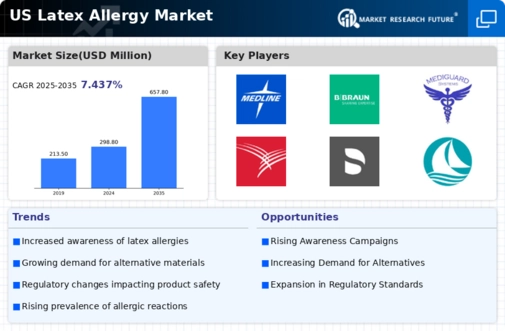The competitive insights of the US Latex Allergy Market reveal a landscape marked by significant challenges and opportunities, primarily driven by a growing awareness of allergic reactions to latex products among healthcare professionals and patients. As a result, companies are increasingly focusing on developing latex-free alternatives and enhancing their product lines to meet the evolving demands of the market. The competitive dynamics are shaped by the urgent need for innovation, stringent regulatory requirements, and a heightened emphasis on patient safety, which drives the exploration of new materials and technologies.
Players in this market are keenly aware of the importance of establishing a robust market presence to leverage opportunities for product differentiation and consumer trust.
As a consequence, strategic alliances, partnerships, and investments in research and development have become prevalent strategies among companies seeking to gain a competitive edge.Smith and Nephew has established itself as a formidable player in the US Latex Allergy Market through its commitment to providing high-quality medical products and solutions that cater to the needs of healthcare professionals and patients alike. The company boasts a diverse portfolio of advanced medical devices that encompass several sectors, including wound care, orthopedics, and surgical instruments, all featuring latex-free options.
Smith and Nephew's strengths lie in its strong brand recognition, deep industry expertise, and extensive distribution network within the United States. This positioning allows the company to effectively respond to the rising prevalence of latex allergies and maintain its competitiveness in the market. By prioritizing patient safety and leveraging its research capabilities, Smith and Nephew continually enhances its offerings to ensure that they address the specific concerns related to latex allergies.
Medline Industries has also emerged as a key player in the US Latex Allergy Market, focusing on delivering a wide range of medical supplies and solutions that are designed to be safe for latex-sensitive patients. The company's product portfolio includes a variety of latex-free gloves, catheters, dressings, and other medical equipment that are pivotal in supporting healthcare providers in delivering optimal patient care.
Medline Industries benefits from significant market presence due to its established relationships with healthcare institutions and its ability to scale its operations across the United States effectively.The company's strengths lie in its commitment to quality, customer service, and innovation in product development, which enables them to anticipate and address the needs of clinicians and patients. In recent years, Medline Industries has pursued strategic mergers and acquisitions to enhance its service offerings and expand its market reach, allowing it to better position itself within the competitive dynamics of the US Latex Allergy Market.
Through these efforts, Medline Industries continues to be a prominent force in providing essential solutions that accommodate the needs of those with latex allergies.












